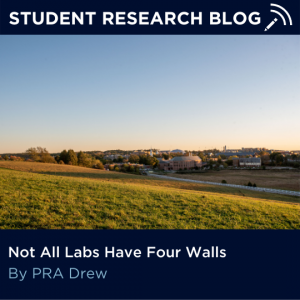 By Drew Tienken, Peer Research Ambassador
By Drew Tienken, Peer Research Ambassador
Think about what you envision when you think of a student research experience. You might imagine someone with a white lab coat hunched over a test tube and meticulously pipetting solutions in search of data. Maybe you think of the lab itself, a pristine little box of four walls full of intimidating equipment and complicated scientific machinery. When imagining what you want your research experience to look like, I challenge you to fight the stigma of this research stereotype, and realize that not all labs have to have four walls.
In fact, my lab has everything but four walls. It has the smell of the ocean breeze, salt crystals hitting your face, lush green meadows of tall grass, and squishy saturated mud beneath my feet. This past summer, I spent my time pursuing a joint University Scholar and SURF project studying the ecological restoration of salt marsh systems. Instead of spending my time indoors to conduct research, I was able to explore a dynamic ecological system that I love while simultaneously enjoying the natural world. This means that many days out of the week I worked outside of the four-wall confines of my lab, and operated alongside a team of other environmental scientists to research protecting important ecosystems from anthropogenic climate change and accelerated sea level rise.
Instead of a pipette in my hand, I typically equip myself with a soil core to extract sediment samples from the salt marsh. Instead of a pristine white lab coat, I wear a seasoned pair of dirty chest waders to ensure I don’t get my clothes ruined while I’m waist-deep in sulfuric and inundated mud. I have no lab goggles or other personal protective equipment, but instead rock a bright yellow fanny pack to hold any of my belongings while tromping around in wetland systems. Despite not having the “traditional” research experience, I’ve gained the same skills as my research peers and have become confident in the quality of my intellectual and scientific pursuits.
Clearly, my lab experience looks different from what most incoming students would imagine one to be. My biggest piece of advice is to not shackle yourself to whichever preconceived notions you have about the research scene at UConn. Different labs and different areas of research conduct science in various ways, and it’s up to you as an individual to explore your options and pick the experience that aligns with your interests the most! The idea of pipetting in a lab coat is definitely relevant to many students involved in undergraduate research, but also downplays the diversity of work and research backgrounds that students and faculty bring to the table.
Before diving head-first into the research scene, take some time to survey the options around you. An incredible tool to do this is called Lincus which allows students to use keywords as a way to find faculty who research topics they’re interested in! When deciding on a lab to join, it should be a mutual decision. Not only is the faculty member who runs the lab learning about you, but you also should decide if that lab’s method of operation fits your academic interests, personality, and your lifestyle. Additionally, it’s okay to change your research trajectory if you find that your current situation doesn’t suit you, or if a new opportunity arises! There’s an overwhelming diversity of research options present at UConn, both within your major and outside of it. I encourage you to take some time to explore these options, and while doing so remember that not all labs have to have four walls.
Drew is a senior double majoring in Environmental Science and Political Science. Click here to learn more about Drew.